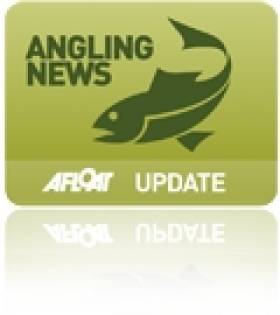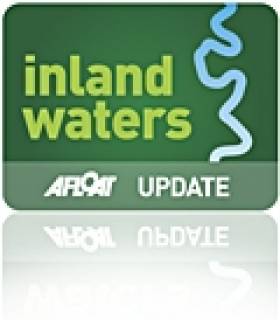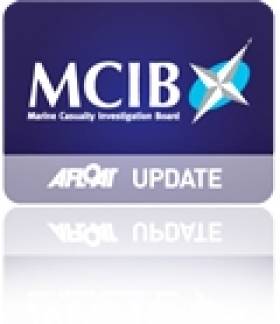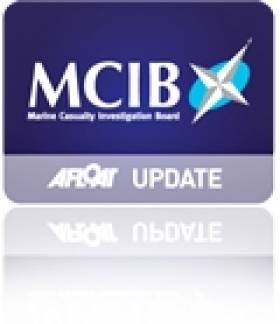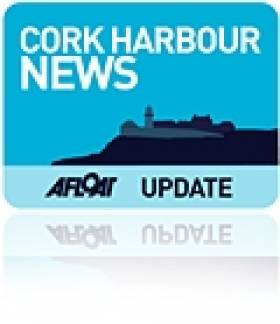Displaying items by tag: report
Irish Maritime Development Office (IMDO) Publishes Q2, 2022 Unitised Traffic Report
The Irish Maritime Development Office (IMDO) has published its Q2, 2022 Unitised Traffic Report with an executive summary below.
In addition to consult the full report, see attachment.
Executive Summary
At the midway stage in 2022, unitised traffic volumes - made up of finished goods such as food, clothing and manufactured products - are performing strongly.
In the Roll – On / Roll – Off (RoRo) market, Dublin Port, Rosslare Europort and the Port of Cork handled a combined total of more than 600,000 units in the first half of the year. This represents 2% growth on 2019, or pre-pandemic, volumes, and means that the RoRo market is now on track to surpass 1.2 million units in 2022, a record annual total.
In the Lift – On / Lift – Off (container) market, traffic volumes are currently at record levels. Dublin Port, the Port of Cork and the Port of Waterford handled 595,000 Twenty-Foot Equivalent Units (TEU’s) in the first half of 2022. This represents 11% growth compared to 2019, or pre-pandemic levels, and 1% growth from 2021. The second quarter of 2022 recorded a total volume of over 311,000 TEU’s, the highest quarterly total on record. Like the RoRo market, the LoLo market is also on course to record 1.2m TEU’s in 2022, surpassing the annual record set in 2021 of 1.18m TEU’s.
Following the end of the Brexit transition period on January 1st 2021, the IMDO reported on the significant impact this event had on the structure of the unitised freight market on the island of Ireland. Eighteen months into the post-Brexit era, these impacts remain unchanged. The following paragraphs encompass the main shifts that have occurred in unitised freight markets in Ireland and Northern Ireland.
Direct Demand
The demand from Irish importers and exporters for RoRo services on direct routes between a port in the Republic of Ireland and a mainland European port (e.g. Cherbourg, Rotterdam) rose dramatically. In 2021, the volume of RoRo traffic on these direct services rose by an unprecedented 94%, from 198,000 units per year, to 383,000. This trend has continued into 2022. One in three RoRo units now travels on a direct route between Ireland and a mainland European port, compared to approximately one in six pre-Brexit.
Since the end of the Brexit transition period, RoRo operators have responded to this demand by introducing unprecedented levels of capacity on direct routes. Incumbents announced increases in fleet size, vessel capacity, as well as intensification of existing schedules. In addition, several new routes were introduced.
The momentum behind this increase in direct capacity has also continued into 2022. In July, Finnlines, a subsidiary of the Grimaldi group, launched a new RoRo route between Rosslare and Zeebrugge. This investment by another new entrant to the Irish RoRo market reemphasizes the persistent nature of this ‘direct demand.’
Intra – Modal Competition
In the LoLo market, the majority of services from ports in the Republic of Ireland are already on direct routes to mainland European ports, such as Rotterdam and Antwerp. Like RoRo operators, LoLo operators have therefore benefitted from the post-Brexit increase in demand from Irish importers and exporters to access EU ports directly, without the need to adhere to new customs requirements at UK ports.
As a result of this change in demand from Irish importers and exporters, intra-modal competition within the unitised freight market (i.e. RoRo Vs LoLo) has increased significantly post-Brexit. Services offered by both operators can be effective substitutes for one another, providing access to central European shipping hubs, meaning operators in both markets compete for similar business.
Loss of Landbridge
Beginning in early 2021, the IMDO has documented the significant declines in RoRo traffic between ports in the Republic of Ireland and Great Britain (i.e. ROI – GB). This traffic has consistently been between 15% and 20% below pre-Brexit levels, and this remains unchanged in 2022. This has been driven by the following three factors.
First, a decline in the demand from Irish importers and exporters to make us of the UK road and ports network as a means to access markets in mainland Europe, a route commonly known and the UK Landbridge. This has been the predominant cause of the decline in ROI – GB traffic. This UK Landridge traffic has, in large part, moved to the direct EU services described above.
Second, a decline in the demand of Northern Irish importers and exporters to make use short sea RoRo services between Republic of Ireland ports and UK ports, particularly Dublin Port, as a means of accessing markets in Southern England and Wales. This can be referred to as the Irish Landbridge. This Irish Landbridge traffic has moved to RoRo services between Northern Irish ports and ports in Great Britain, (i.e. NI – GB), driving record volumes on these routes, and causing further losses for Irish port traffic.
Lastly, the relocation of distribution hubs from Great Britain to mainland European countries has amplified the reduction in ROI – GB traffic. Following the end of the Brexit transition period, several large retail companies with Irish stores have relocated distribution warehouses from areas such as southern England, to areas such as northern France and the Benelux region.
In all of the cases described, the imposition of customs declarations and customs checks on trade between the EU and the UK has underscored these shifts in Irish freight traffic patterns.
Conclusions
The IMDO has noted in previous reporting that Brexit has fundamentally altered the composition of Irish maritime freight traffic. At the midway point in 2022, this remains the case. Direct demand in RoRo and LoLo markets is at record levels, with more new RoRo routes added in the second quarter of 2022. Roro traffic on GB routes continues to record declines of between 15% and 20%, with no immediate signs of a return of Northern Irish traffic or UK Landbridge traffic to pre-Brexit levels at Irish ports.
Overall, unitised freight traffic in Ireland is strong, given the many challenges faced over the past two years. However, economic headwinds such as inflation, high energy costs, elevated containership freight rates, and persistent port congestion at major hubs have meant that the outlook for global seaborne trade is increasingly negative. Despite the extremely high levels of uncertainty, the Irish maritime sector has, since the outbreak of the COVID-19 pandemic, proven its considerable resilience and adaptability to changing global circumstances. These characteristics may be required again in the latter half of 2022.
In an urgent need to address gaps in maritime and air security, and the threat posed by cyber attacks, they feature prominently in submissions made to the country's first national security strategy.
A total of 60 submissions have been made in a public consultation launched by the newly-established National Security Analysis Centre.
The NSAC, based within the Department of the Taoiseach, is drawing up the State's first-ever National Security Strategy.
While the submissions have not yet been published by the department a number are available on the websites of bodies that have made them
In its detailed submission, the Association of Retired Commissioned Officers (ARCO) said the threats to Ireland's national security range from energy security, espionage and extremism to hybrid warfare, major pandemics, nuclear contamination and terrorism.
The submission, authored by Brigadier-General Paul Pakenham (Retd), said that ISIS is “likely to reemerge in the short to medium term”.
It said the concept of military neutrality was “flawed and outdated” and that cyber-enabled attacks and hybrid warfare “do not respect Ireland's military neutrality posture".
ARCO said a “substantial increase” in investment in defence capabilities is required, pointing out that Ireland has the lowest defence spend in the EU, at 0.3% of GDP (average 1.3%).
It said the trans American-European sea and air lanes are in “close proximity” to Ireland and that Ireland's significant reliance on sea lanes presents a potential risk.
The Irish Maritime Forum, an independent professional body, also looked at on sea lanes of communication.
It wants an increased focus, by boosting the Naval Service, to protect Ireland's maritime domain, which is the largest in northwest Europe, with 92% of Ireland's area being underwater.
“We are a small trading nation living on an island and 99% (by volume) of everything we import or export is transported by sea," it said.
“The sea and air traffic between northern Europe and the USA passes close to our shores and through or above waters over which we have jurisdiction or for which we have responsibility.”
Much more from BreakingNews.ie here.
#Angling - Almost one in every 10 people in Northern Ireland went fishing in the last 12 months - but 70% of NI residents said they had no interest in the sport.
These statistics were among the key findings in a new report on attitudes to angling by adults in Northern Ireland, using data from the Northern Ireland Omnibus Survey conducted this past April.
As the Belfast Telegraph reports, among the other findings were that almost a fifth of the population used to go fishing but no longer so do, while some 4% of the populace have never fished before and would like to try.
Most respondents cited their lack of interest in putting them off angling as a pastime, while 19% said they did not have enough free time.
But 12% said better information on how to fish would encourage them to take out a rod and reel.
The Belfast Telegraph has more on the story HERE.
#MCIB - The families of two fishermen found dead at sea off the Skerries last April may never uncover the circumstances that led to their demise. But the official report into the incident indicated that the absence of lifejackets was a significant contributing factor.
Ronan Browne (26) and David Gilsenan (41) were reported missing on the evening of 1 April after failing to return from a trip tending to lobster pots.
Their vessel, Lady Linda, was found the following morning upturned in an oil slick off Clogherhead with no sign of the crew.
It wasn't until a week later that their bodies were discovered caught in the vessel's fishing gear some five miles east of Clogherhead, as previously reported on Afloat.ie.
Post-mortem results found that both men died from drowning, with Gilsenan also showing signs of hypothermia.
With no eyewitnesses to the incident, the report by the Marine Casualty Investigation Board (MCIB) indicated a number of possible causes from eqiupment malfunction or shifting of lobster pots on deck, to the wave height and weather conditions on the day, which were reportedly deteriorating when the boat left port.
It also said that Browne and Gilsenan "were lifelong friends, both men were experienced and qualified marine engineers in the fishing vessel industry. Both men were experienced in boat handling and fishing and had worked together on many occasions."
But the report emphasised the lack of personal flotation devices (PFDs) on board, and noted that emergency equipment was stored under the deck and not easily accessible.
The MCIB's recommendations include a review of the code of practice for fishing vessels under 15m to establish "revised stability critera" and ensuring that all boats are fitted with automatic radio beacons that deploy upon capsize.
In a separate incident, lack of proper maintenance led to an unlicenced boat taking on water off Co Kerry last August.
The Claire Buoyant was carrying one crew, five passengers and 21 sheep from Beginish Island to Ventry when the vessel began to lose stability.
Skipper Eoin Firtear - who the MCIB described as having "limited sea-going experience" - and his five passengers were rescued by passenger ferry. All sheep were jettisoned overboard, with 18 eventually recovered.
The report reminded that the carriage of livestock should only be undertaken in appropriately certified vessels.
- MCIB
- Marine Casualty Investigation Board
- report
- Lady Linda
- Clogherhead
- Ronan Browne
- David Gilsenan
- lobster pots
- Fishing
- drowning
- hypothermia
- missing
- malfunction
- wave height
- Weather
- lifejackets
- Personal Flotation Devices
- PFDs
- Code of Practice
- stability
- Radio
- beacon
- maintenance
- unlicenced
- Co Kerry
- Claire Buoyant
- Sheep
- Passengers
- Beginish Island
- Ventry
- Eoin Firtear
- Skipper
- Rescue
- Livestock
Bridge Report Could Herald New Corrib Crossing for Galway
#RIVER CORRIB - A consultant’s report on Wolfe Tone Bridge in Galway could clear the way for a new crossing of the River Corrib, according to The Connacht Sentinel.
Galway City Council has confirmed that the €400,000 report will look at the possibility of a new bridge for vehicular traffic downstream of the existing span.
“Given the age of the current structure, we have to look at plans for the construction of a new bridge and the retention of the existing crossing as part of a walkway over the Corrib," said the council's director of services Ciarán Hayes.
“There is no doubt that such a walkway, as part as an overall regeneration plan for the area, would be a most welcome addition to the amenity infrastructure of this historic part of the city."
The €400,000 allocation for the report commission will comes from the National Roads Authority and Department of the Environment budget for regional and local roads in 2012. The report is expected to be carried out later this year.
Epilepsy, Lack of Lifejacket Big Factors in Death of Dublin Boatman - MCIB
#MCIB - The death by drowning of a South Dublin boatman may have been avoided had he been wearing a lifejacket or buoyancy aid, according to investigators.
The report by the Marine Casualty Investigation Board (MCIB) into the death of Aidan Fennell off Dalkey Island on 12 October 2010 found that an epileptic episode could have caused him to fall overboard from his rowboat and become disorientated once in the water.
Fennell, 43, was considered a competent boatman and a strong swimmer used to cold water, though was prone to seizures where he could not control his muscles and lost sense with reality, on occasion becoming unconscious.
On the afternoon of 12 October last year Fennell had launched his boat from Coliemore Harbour in fair conditions, intending to ferry a German family to Dalkey Island. When they pulled out of the trip, Fennell decided to row to the island on his own, with no flotation devices on board.
He was last seen by friend Kevin O'Farrell at 2.50pm. Around half an hour later, O'Farrell became concerned as to Fennell's whereabouts when he had been out of sight for some time.
After notifying the Irish Coast Guard, the Dun Laoghaire lifeboat and coastguard helicopter Rescue 116 were dispatched to search the area. Fennell's boat was located before 4pm washed on the rocks at the southeast end of Dalkey Island, and his body was found in the water close by some 10 minutes later.
No injuries were found on Fennell's body, suggesting that he went into the water before his boat washed up on the rocks.
The report concluded that if he had fallen overboard in normal conditions "it is considered likely that he could have swum to his boat, or clung on to the oars.
"However, if he had suffered an epileptic episode... he would have had great difficulty in staying afloat, in particular without having the buoyancy assistance of a life jacket."
The full report is available to download as a PDF from the MCIB website HERE.
Public Needed to Help Record Whale and Dolphin Strandings in UK
#MARINE WILDLIFE - Some 46 reports of stranded whales and dolphins in Northern Ireland are among the thousands recorded across the UK over the last six years, according to BBC News.
A new study co-ordinated by the Zoological Socoety of London (ZSL) shows that some 3,500 cetaceans were stranded on the British coastline between 2005 and 2010.
Though year-on-year figures have fallen overall, is presumed that many more strandings have gone undetected.
Many were found to have died of disease or starvation – particular harbour dolphins.
But human activity such as fishing, shipping and chemical pollution also poses a significant threat to marine wildlife in the waters around the British Isles, said Rob Deaville of the ZSL.
The public is being encouraged to report stranded marine mammals to help create a more accurate picture.
BBC News has more on the story HERE.
Families Disagree with MCIB Report on F/V Jennifer
The Irish Examiner reports that the families of two fisherman who drowned off Malin Head last November disagree with the findings of the official investigation into the tragedy.
Eddie Doherty, 65, and his nephew Robert McLaughlin, 41, died after their small fishing boat F/V Jennifer capsized and sank off Glengad on 1 November last year.
The official report released last week by the Marine Casualty Investigation Board (MCIB) found that a combination of high winds in the area and unstable weight on the boat due to the crab pots it was carrying most likely caused the vessel to list to an angle from which it could not be recovered.
But Eddie Doherty's widow said she disagreed with this conclusion.
"With Eddie’s experience and his regard for safety the load would have been spread evenly over the deck of the boat and therefore this would not have had an adverse affect on the stability of the boat," said Marian Doherty.
The full MCIB report is available to read in full HERE.
Public Consultation on Cork Harbour's Future
A public consultation on the future of Cork Harbour is open until 15 July.
Copies of the 300-page Cork Harbour Study are currently available at Cork County Council offices and online at www.corkcoco.ie, The Southern Star reports.
The study outlines possibilities for the long-term future of the coastline in and around the harbour, including but not limited to the development of disused or under-used areas, and sustainable patterns of settlement and industry.
Ideas the report puts forward for public debate include a new marina for Cobh, more shoreline pedestrian and cycleways, a new container terminal at Ringaskiddy and initiatives for marine-related employment.
"A balance between the development and amenity roles of Cork Harbour is only likely to be maintained if there is public support for this," said outgoing Cork Mayor Kevin Murphy. "Greater use and better public access to its amenities and recreational facilities will make this more likely."
The report by the Marine Casualty Investigation Board (MCIB) into the loss of a kayaker in Castletownshend last year has found the death was caused by hypothermia and heart failure due to a pre-existing condition.
Didier Heneault, 56, died while kayaking with his wife Margaret near Horse Island, after his kayak overturned in choppy water.
The French couple, who were experienced kayakers, had set off from the League near Raheen Town in Co Cork on the morning of 30 May 2010, paddling south-east.
On the western side of Horse Island, Mrs Heneault turned and saw that her husband was in thw water about 10m from his kayak. She tried to assist him in climbing out of the water back into the kayak but was unsuccessful.
Mrs Heneault used a safety rope to keep her husband afloat, but after 10 minutes he became unresponsive.
Some hours later passing kayakers heard Mrs Heneault's calls for help and assisted in towing the couple back to shore at Horse Island, where they gave Mr Heneault CPR. They were joined shortly after by the Baltimore Inshore Lifeboat and the Toe Head coastguard unit.
Mr Heneault was transferred to a waiting ambulance at Castletownshend pier where he was treated by paramedics before being taken to Cork University Hospital. There he was pronounced dead at 4.50pm.
The report into the incident by the MCIB said the post-mortem gave the cause of death as cardiac failure due to hypertensive cardiomyopathy following immersion in cold water and associated hypothermia, with a medical history of hypertension.
The report also recommended that lifejackets should be used instead of buoyancy aids when offsore kayaking, where the risk of capsizing is greater. A lifejacket of 150 Newtons or more would have kept Mr Heneault's head above water at all times, it said.



























